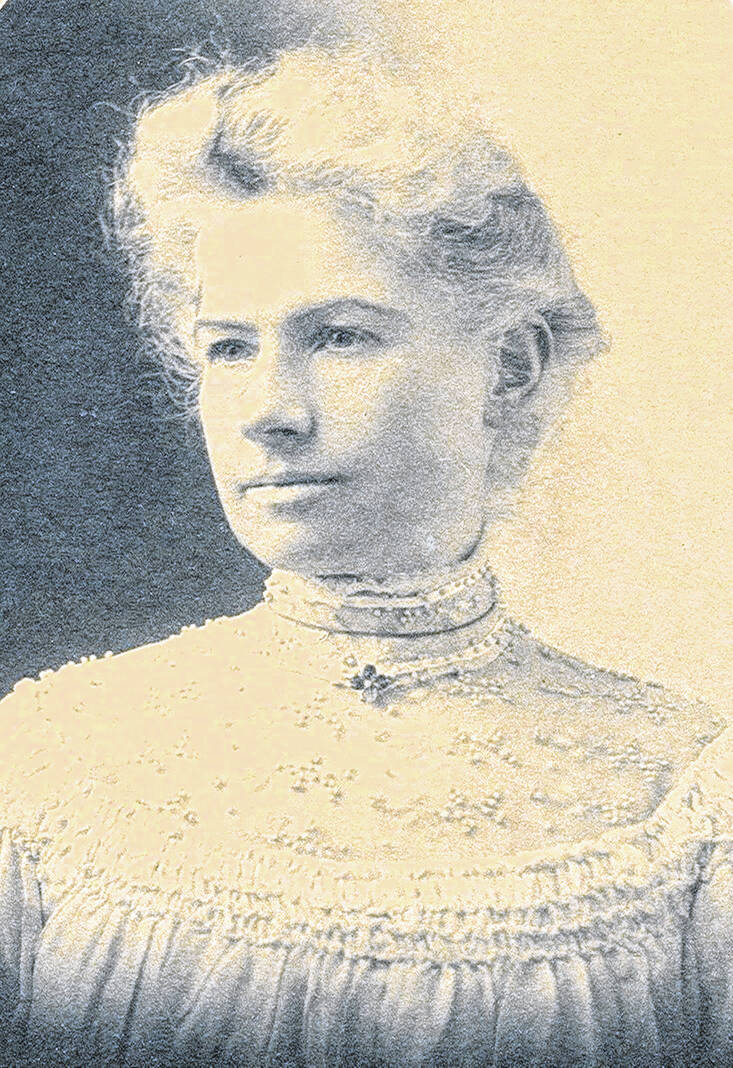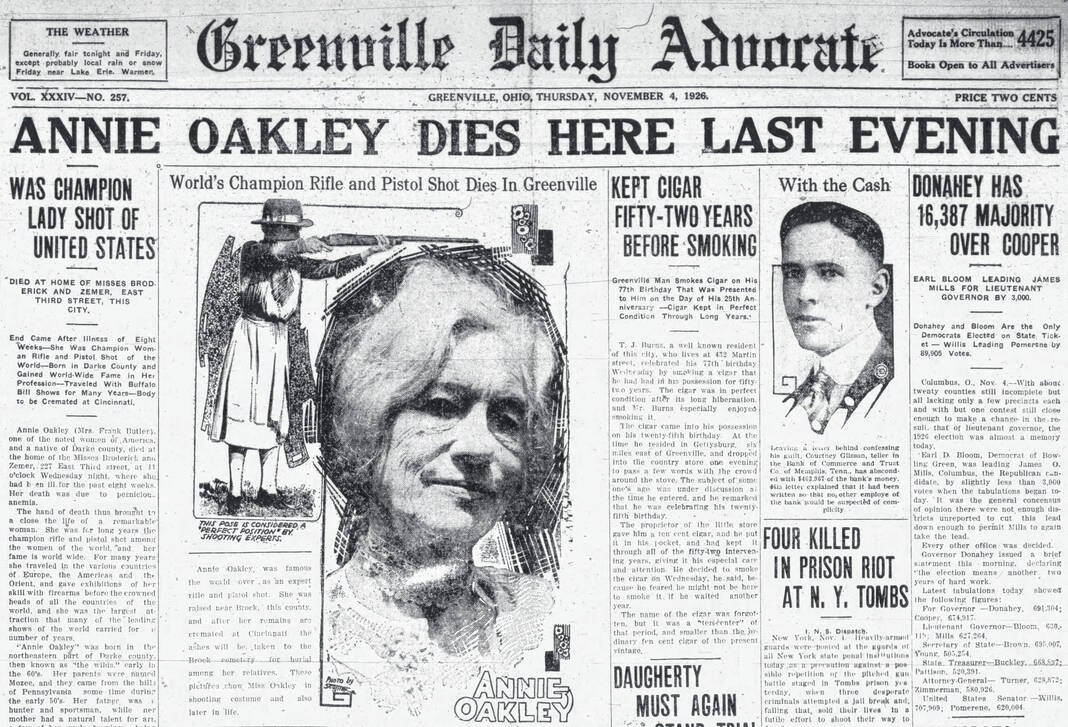
Annie Oakley
Courtesy of Garst Museum and Annie Oakley Center

Shown is a portion of the Greenville Daily Advocate the ran on Nov. 4, 1926.
Courtesy of Garst Museum Research Center
By Ryan Berry
DailyAdvocate.com
GREENVILLE — Greenville is once again honoring Annie Oakley with a mural installed on Sure Shot Tap House. The mural installation coincided with the 97th anniversary of when Darke County’s legendary sharpshooter took her final breath on Nov. 3, 1926. The day following her death, the Greenville Daily Advocate’s headline read, Oakley Dies Here Last Evening. The publication ran a recap of Oakley’s life and praised her contributions to society. The following are portions of what was written upon her death. “Annie Oakley (Mrs. Frank Butler), one of the noted women of American, and a native of Darke County, died at the home of the Misses Broderick and Zemer, 227 East Third Street, at 11 o’clock Wednesday night, where she had been ill for the past eight weeks. Her death was due to pernicious anemia.
The hand of death thus brought to a close the life of a remarkable woman. She was for long years the champion rifle and pistol shot among the women of the world, and her fame is world wide. For many years she traveled in the various countries of Europe, the Americas and the Orient, and gave exhibitions of her skill with firearms before the crowned heads of all countries of the world, and she was the largest attraction that many of the leading shows of the world carried for a number of years.”
The article continues by discussing her formative years and how her father was a hunter and sportsman, and her mother had a “natural talent for art.” However, they were “very poor”, but hard working.
The article continued, “The ability of Annie to handle a gun seems to have come with her birth. At the age of six years she would secretly follow her brother when he went hunting, and when discovered would plead to be permitted to go along.
When about eight years of age she had her first experience with a rifle. Seeing a squirrel at play on a rail fence one day when alone, she got down her father’s old muzzle loader, and resting the gun across a limb, cut the squirrel’s throat with a bullet.”
She was occasionally allowed to shoot after that, but, at the age of 12, she was given a rifle and shotgun.
The article discussed Oakley’s early education and noted it was limited. Her father died when she was nine years old, and she began working for a living. “Her father died, leaving a family of small children, and a heavily mortgaged farm, and Annie, by hunting and trapping quail and other game, and by manual labor, was able to pay off the mortgage in five years.”
Then she met Frank Butler. “Miss Oakley went to Cincinnati to make her home with a sister about the time of her sixteenth year. Here she met and married Frank E. Butler, a fine and genial man and an expert shot, whom she met at a shooting match. With him she later visited all of the countries of the world, the two giving exhibitions on their prowess with guns.”
The article discussed Oakley’s public life and her stint with the Buffalo Bill’s Wild West Show, beginning in the spring of 1885. She was with the show for 17 years and visited 14 countries.
“Annie Oakley gave five exhibitions before the Prince of Wales, now King of England, and shot game on his estate at Sandringham. Long lists of names of the nobility who had entertained her are among her treasured papers, and is said no American lady, save Mary Anderson, was received more cordially by the society of the world than she.”
How good of a shot was Oakley? The article states, “During her career, Annie Oakley established many records with a rifle, among her best being the breaking of 945 tossed balls out of a 1000; 96 small clay pigeons out of 100, 50 straight double clays and 49 live birds out of 50. It is also recorded that she broke 4,772 glass balls out of 5,000 in one day’s shooting.”
While one might think Oakley, with all of her accomplishments, would have an ego, the article clarified that she did not. “Annie Oakley was slight in build, a little below the average in height. She had clear, keen, blue-gray eyes, and black flowing hair that turned white in one night while in a train wreck. She possessed a rare modesty for a person that had followed the life she did, and was unaffected and sincere, and of charming personality.”
Oakley visited Darke County and her family as often as she could. Towards the end of the article, her return to Darke County, arrangements and death were detailed.
“Six months ago the noted lady came back to old Darke, the county of her birth, and visited with her sister Mrs. Bonnie Blakeley, near Versailles. Six weeks ago, realizing that her end was near, she came to Greenville, to the home of Miss Harriet Zemer, where she gradually passed out of this life.
Prior to her death, Annie Oakley had made all of her arrangements that she wished carried out after her demise. Her will was arranged, and she had purchased a lot in the beautiful little cemetery near the village of Brock, twelve miles north of here, and near the place of her birth, and here her body will find its final rest. She had disposed of all of her great array of medals, expensive gifts, books, etc. to friends and relatives prior to her passing.
The aged husband, now 76, and the faithful loving wife, who passed long years together, were fated to be separated in death. When the death angel laid its cold hand on her brow, he was confined to his bed in the home of her sister, Mrs. Huldah Haines, at Ferndale, Michigan, a suburb of Detroit. He will soon pass on to the land whence his noted helpmate has journeyed.”
The final paragraph read, “Annie Oakley is no more, but her feats with the rifle, and her love for those of her profession, especially those whom misfortune overtook, will always remain a memorial to her.”
You can learn more about Annie Oakley at the Garst Museum and The National Annie Oakley Center, 205. N. Broadway, Greenville. The museum is open 10 a.m. to 4 p.m., Tuesday through Saturday. For more information, visit www.garstmuseum.org.




